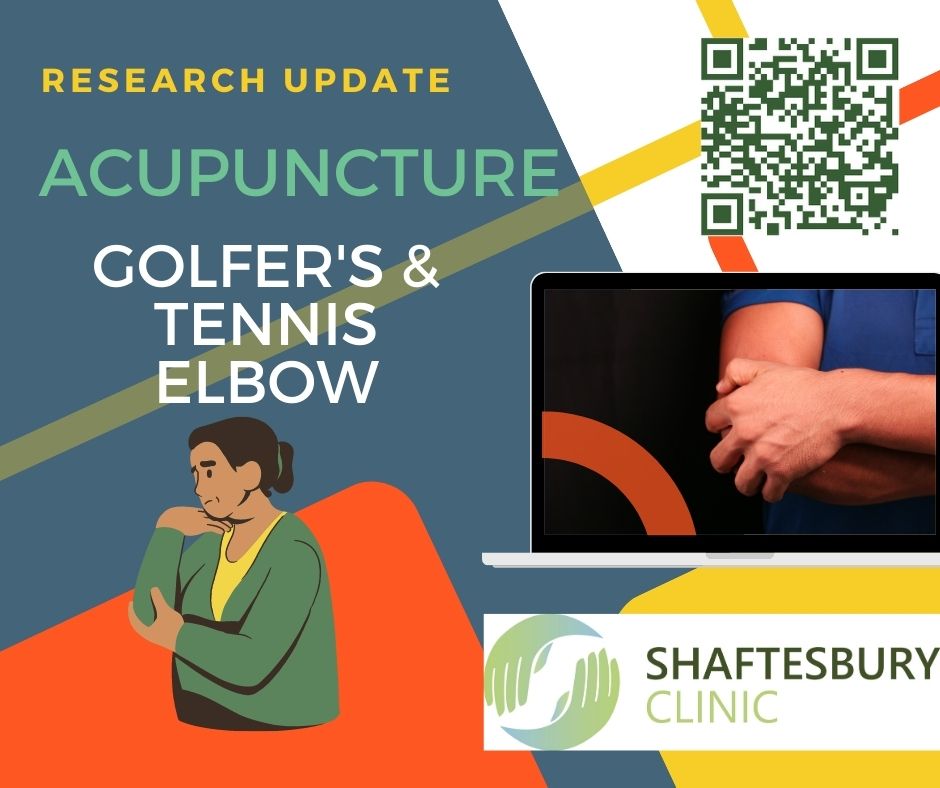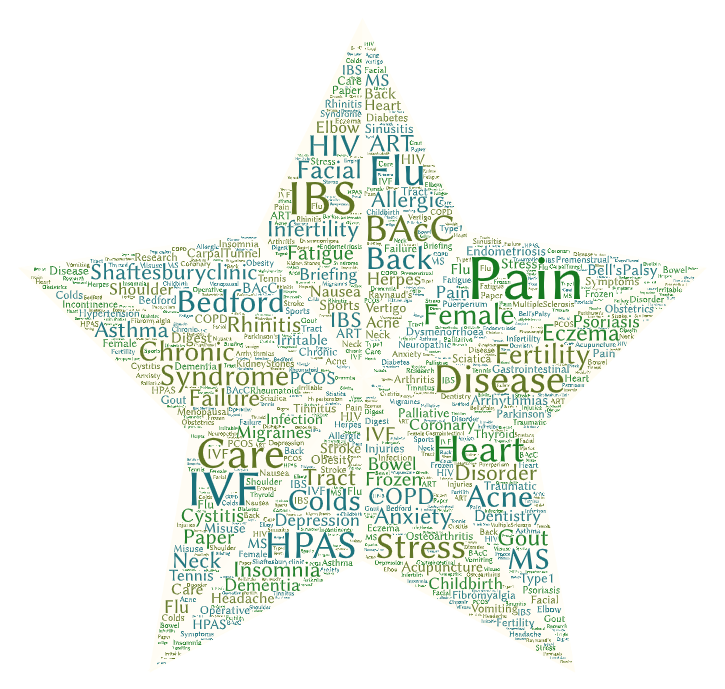Important to know: Chronic health conditions should be addressed under direct medical supervision of your GP or consultant, and acupuncture would be an adjunct or complement to usual care – we advise that you let you doctor know when you use this approach.
Chronic Pain in General
“Acupuncture is effective for the treatment of chronic musculoskeletal, headache, and osteoarthritis pain. Treatment effects of acupuncture persist over time and cannot be explained solely in terms of placebo effects. Referral for a course of acupuncture treatment is a reasonable option for a patient with chronic pain”. (Vickers et al, 2018: large chronic pain review of high quality RCTs updating a previous meta-analysis; 39 trials, n=20827; conditions addressed chronic headache, back/neck pain and osteoarthritis)
Another recent overview (Yin et al, 2017) confirms that there is increasing evidence for acupuncture as an effective, safe, and cost-effective intervention in chronic low back, neck, shoulder, and knee pain, as well as headaches.
The NHS body in charge of which treatments should be used in particular conditions recommends acupuncture for chronic pain: The NICE Scenario Management guidelines (2021) for chronic pain state: “consider a course of acupuncture or dry needling, within a traditional Chinese or Western acupuncture system”
Overall, a large systematic review has found acupuncture a cost effective intervention for several painful conditions (Ambrósio et al, 2012).
Tennis Elbow
The British Acupuncture Council has a Research digest where they examined some recent studies on lateral elbow pain, as well as an evidence based factsheet (tennis elbow – links are below), finding promising evidence in the field.
Gadau et al, (2014) conducted a systematic review of 19 RCTs of varying quality were examined, and overall the evidence suggested acupuncture was more effective than sham control. Tang et al (2015) looed at a smaller number of RCT and were more tentative about the outcomes due to concern over trial designs and highlighted a need for further research.
Recent small trials include one comparing acupuncture and manipulation (n=35; Hsu et al, 2016) in which both groups experienced improvement in pain and function. Another looked at ultrasound imaging of the affected tendon to evaluate acupuncture’s effect, finding reduction of tendon thickness after 10 sessions as well as improvement in pain scores (Ural et al 2017; n-41). A further trial (Wong et al, 2017; n=34) compared acupuncture and extracorporeal shockwave therapy (ESWT), finding a trend of improvement in pain scores in both groups.
Mechanisms of Action
Acupuncture stimulates the body to create its own natural painkilling substances, such as Beta Endorphins (β-Endorphin). In studies acupuncture has been shown to stimulate the production of natural painkillers called opioid-like peptides (OLPs), including β-Endorphin: For example, this was shown in an RCT in 90 patients with a range of painful disorders (Petti et al, 1998). The same study showed acupuncture also and enhanced the activity of immune cells (lymphocytes, natural killer cells and monocytes) that help fight infections and diseases (Petti et al, 1998).
About the research: It is worth noting that in research, randomised controlled studies (RCT) are the most reliable in terms of quality of evidence, with a systematic review or meta analysis of numerous studies being the best way of seeing the overall picture of the state of the evidence. Below we have a selection of the available research, which does include some larger RCTs, and reviews of the literature alongside smaller studies. The n= figure tells you how many people were participants in the study.
Resources:
British Acupuncture Council (BAcC) evidence based factsheet about Tennis and Golfers Elbow including specific research, trials and mechanisms of action for acupuncture in this condition.
BAcC Sports Injuries Factsheet
BAcC Research Digest
References:
General Chronic Pain References:
Ambrósio, E.M.M., Bloor, K. and MacPherson, H., 2012. Costs and consequences of acupuncture as a treatment for chronic pain: a systematic review of economic evaluations conducted alongside randomised controlled trials. Complementary therapies in medicine, 20(5), pp.364-374.
Vickers, A.J., Vertosick, E.A., Lewith, G., MacPherson, H., Foster, N.E., Sherman, K.J., Irnich, D., Witt, C.M., Linde, K. and Acupuncture Trialists’ Collaboration, 2018. Acupuncture for chronic pain: update of an individual patient data meta-analysis. The Journal of Pain, 19(5), pp.455-474.
Birch, S., Lee, M.S., Alraek, T. and Kim, T.H., 2018. Overview of treatment guidelines and clinical practical guidelines that recommend the use of acupuncture: a bibliometric analysis. The Journal of Alternative and Complementary Medicine, 24(8), pp.752-769.
NICE 2021 Chronic pain: Scenario: Management Last revised in April 2021
Petti, F.., Bangrazi, A., Liguori, A., Reale, G. and Ippoliti, F., 1998. Effects of acupuncture on immune response related to opioid-like peptides. Journal of Traditional Chinese Medicine 18(1), pp.55-63.
Yin, C., Buchheit, T.E. and Park, J.J., 2017. Acupuncture for chronic pain: an update and critical overview. Current opinion in anaesthesiology, 30(5), pp.583-592.
Tennis Elbow References:
Gadau, M., Yeung, W.F., Liu, H., Zaslawski, C., Tan, Y.S., Wang, F.C., Bangrazi, S., Chung, K.F., Bian, Z.X. and Zhang, S.P., 2014. Acupuncture and moxibustion for lateral elbow pain: a systematic review of randomized controlled trials. BMC Complementary and Alternative Medicine, 14(1), pp.1-19.
Tang, H., Fan, H., Chen, J., Yang, M., Yi, X., Dai, G., Chen, J., Tang, L., Rong, H., Wu, J. and Liang, F., 2015. Acupuncture for lateral epicondylitis: a systematic review. Evidence-based complementary and alternative medicine, 2015.
Hsu, C.Y., Lee, K.H., Huang, H.C., Chang, Z.Y., Chen, H.Y. and Yang, T.H., 2016. Manipulation therapy relieved pain more rapidly than acupuncture among lateral epicondylalgia (tennis elbow) patients: a randomized controlled trial with 8-week follow-up. Evidence-Based Complementary and Alternative Medicine, 2016.
Ural, F.G., Öztürk, G.T., Bölük, H. and Akkuş, S., 2017. Ultrasonographic evaluation of acupuncture effect on common extensor tendon thickness in patients with lateral epicondylitis: a randomized controlled study. The Journal of Alternative and Complementary Medicine, 23(10), pp.819-822.
Wong, C.W.Y., Ng, E.Y.L., Fung, P.W., Mok, K.M., Yung, P.S.H. and Chan, K.M., 2017. Comparison of treatment effects on lateral epicondylitis between acupuncture and extracorporeal shockwave therapy. Asia-Pacific journal of sports medicine, arthroscopy, rehabilitation and technology, 7, pp.21-26.


